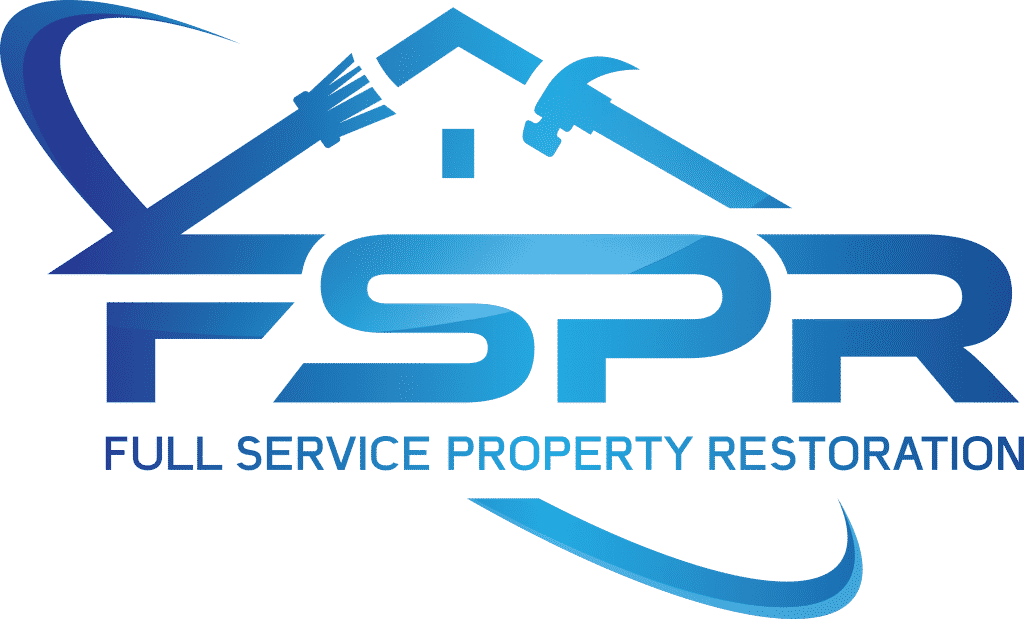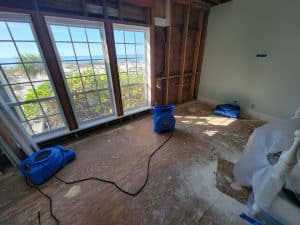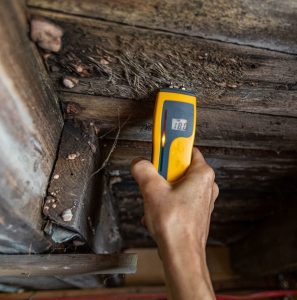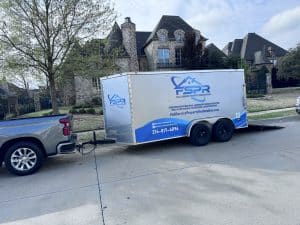Key Takeaways
- Mold can grow within 24-48 hours after water damage, so act fast.
- Remove standing water immediately using pumps, vacuums, and towels.
- Dry out the area completely with fans, dehumidifiers, and proper ventilation.
- Discard porous materials that cannot be dried properly, like wet carpets and drywall.
- Clean and disinfect surfaces with mold-killing solutions.
- Monitor humidity levels to prevent mold from returning.
Call a professional if mold persists or if you need help with water damage restoration.
At Full Service Property Restoration, we know firsthand how stressful water damage can be. Whether it’s from a burst pipe, a flood, or an unexpected leak, dealing with water in your home or business is no small task. One of the biggest concerns after water damage is mold growth. If it is not handled properly, mold can spread quickly and cause serious health risks, not to mention structural damage to your property.
That’s why we are here to help! In this guide, we’ll walk you through the best ways to prevent mold growth after water damage. By taking the right steps early, you can protect your home, your health, and your peace of mind.
Understanding the Mold Problem
Mold is a type of fungus that thrives in damp, humid environments. After water damage, your home or business provides the perfect conditions for mold to grow. It only takes 24 to 48 hours for mold spores to start spreading on wet surfaces, which means quick action is essential.
Mold can appear as black, green, or white spots on walls, ceilings, and floors. It often has a musty odor and can trigger allergies, asthma, and other respiratory problems. The key to preventing mold is to dry out your space as soon as possible and remove any materials that can’t be salvaged.
Step 1: Remove Standing Water Immediately
The first step in preventing mold growth is to remove standing water as quickly as possible. Here’s what you need to do:
- Use a Wet/Dry Vacuum – If there’s a small amount of water, a wet/dry vacuum can help suck it up quickly.
- Pump Out Large Volumes of Water – For significant flooding, you may need to use a sump pump or call a professional restoration company (like us!) for proper water extraction.
- Use Towels and Mops – In minor cases, absorbent towels and mops can help soak up water from hard surfaces.
The sooner you remove the water, the lower the chance of mold developing. And don’t forget that if you need help, a good professional like Full Service can handle all of this and more!
Step 2: Dry Out the Area Right Away
After the standing water is gone, the next step is to thoroughly dry the affected area. Mold thrives in moisture, so eliminating dampness is crucial. Here’s how you can speed up the drying process:
- Open Windows and Doors – If weather permits, increase airflow by opening doors and windows to allow fresh air in.
- Use Fans and Dehumidifiers – Place fans around the affected areas to circulate air. A dehumidifier can help pull moisture out of the air and speed up drying.
- Turn on the AC or Heat – Depending on the season, running your air conditioner or heater can help regulate indoor humidity levels.
It’s important to dry everything completely, including walls, floors, carpets, and furniture.
Step 3: Remove Damaged Materials
Not everything can be saved after water damage. Mold loves to grow on porous materials, so anything that stays wet for too long may need to be removed. Here’s what to consider:
- Carpets and Rugs – If they’ve been soaked for more than 24 hours, they may be difficult to fully dry and should be removed or professionally attended to.
- Drywall and Insulation – Water-damaged drywall and insulation can trap moisture and lead to hidden mold growth.
- Furniture and Upholstery – If furniture is heavily soaked and cannot be dried completely, it may need to be replaced.
When in doubt, consult a professional to assess what can be salvaged and what should be discarded.
Step 4: Clean and Disinfect
Once everything is dry, it’s time to clean and disinfect the area to eliminate any lingering mold spores. There is a lot of hearsay out there about what you can and cannot use in order to properly address and clean/disinfect the area. When in doubt- reach out to your favorite professional for advice.
Be sure to wear gloves and a mask when cleaning to avoid inhaling mold spores.
Step 5: Monitor Humidity Levels
Even after the cleanup, mold can still return if humidity levels are too high. To keep mold at bay:
- Use a Hygrometer – This tool measures humidity levels in your home. Keep indoor humidity below 50% to prevent mold growth.
- Run a Dehumidifier – If your home tends to be humid, a dehumidifier can help maintain the right moisture levels.
- Fix Leaks Immediately – Check for any ongoing leaks in pipes, roofs, or walls and fix them as soon as possible.
Step 6: Call a Professional if Needed
Sometimes, despite your best efforts, mold can still develop. If you notice a musty smell, see mold growing, or experience persistent water issues, it’s time to call a professional mold remediation service. At Full Service Property Restoration, we specialize in water damage restoration and mold removal. Our team has the tools, expertise, and experience to properly treat and prevent mold growth in your home or business.
Final Thoughts
Dealing with water damage is never fun, but taking the right steps can save you time, money, and stress. By acting quickly and thoroughly drying out your space, you can prevent mold growth and keep your property safe. If you ever need expert assistance, Full Service Property Restoration is here to help!
Need water damage cleanup or mold remediation? Give us a call today!




